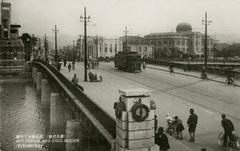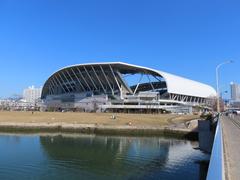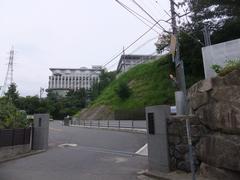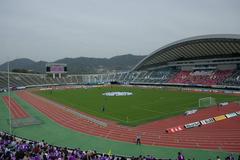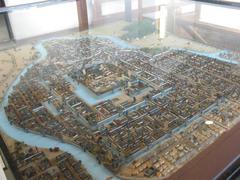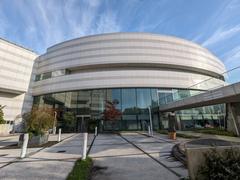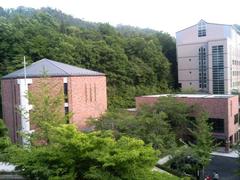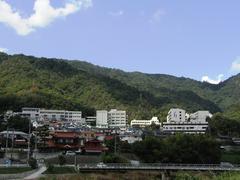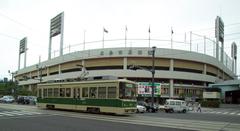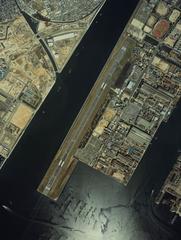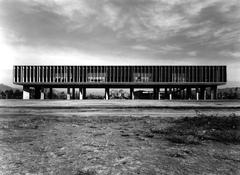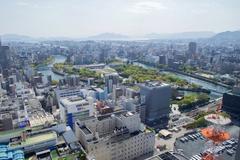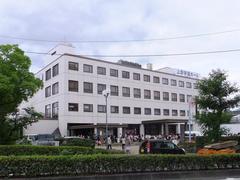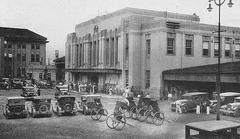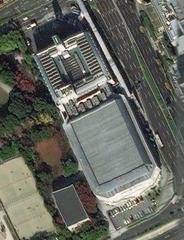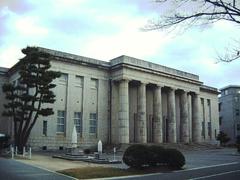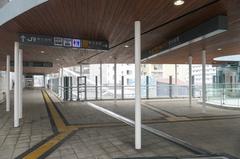Fudōin-Mae Station Hiroshima: Visiting Hours, Tickets, and Nearby Attractions
Date: 04/07/2025
Introduction to Fudōin-Mae Station
Fudōin-Mae Station is an important stop on the Hiroshima Electric Railway (Hiroden) Hakushima Line, providing seamless transit access to northern Hiroshima’s rich array of historical, cultural, and spiritual sites. Since its opening in 1912, the station has connected residents and visitors to significant landmarks, most notably the nearby Fudō-in Temple—a Muromachi-period National Treasure renowned for its resilience and architectural beauty. The station’s strategic location also places it within reach of Hiroshima Castle, Peace Memorial Park, and other major attractions.
Fudōin-Mae Station has played a critical role in Hiroshima’s recovery and modernization, particularly following the devastation of the 1945 atomic bombing. Today, the station features modern amenities such as barrier-free access and IC card-compatible ticketing, making it accessible and convenient for all travelers. Whether you are a history enthusiast, cultural explorer, or spiritual seeker, this guide offers essential information for an enriching visit to Fudōin-Mae Station and its remarkable surroundings.
For more detailed background on Fudō-in Temple’s history and visitor guidelines, see Tourist in Japan. For transportation and ticketing details, refer to JapanTravel and the City of Hiroshima.
Contents
- Overview and Historical Background
- Station Services & Visitor Information
- Visiting Hours
- Tickets and Fares
- Accessibility
- Travel Tips
- Nearby Attractions
- Special Events
- Frequently Asked Questions (FAQ)
- Practical Summary and Visitor Tips
- References
Overview and Historical Background
Origins and Development
Fudōin-Mae Station (不動院前駅) was established in 1912 during a period of rapid urban growth in Hiroshima. Its proximity to Fudō-in Temple—one of the city’s oldest and most significant Buddhist temples—made it a vital link for both residents and visitors. The station played a central role in connecting educational institutions, military facilities, and residential neighborhoods, especially during Hiroshima’s expansion as an administrative and military hub in the early 20th century.
Postwar Significance and Modernization
After suffering damage in the atomic bombing of 1945, Hiroshima Electric Railway restored partial operations within three days, underscoring the city’s resilience. Fudōin-Mae Station, located roughly 2.5 kilometers from the blast epicenter, was instrumental in reconnecting northern districts during the city’s reconstruction. Subsequent modernization included integration with the Astram Line in 1994, and continuous upgrades have ensured barrier-free access, multilingual signage, and convenient ticketing for today’s travelers.
Station Services & Visitor Information
Visiting Hours
- Fudōin-Mae Station: Operates daily along the Hiroden Hakushima Line schedule, from approximately 5:30 AM to midnight. As a streetcar stop, it does not have separate opening or closing hours.
- Fudō-in Temple: Open to visitors from 9:00 AM to 5:00 PM (last admission at 4:30 PM).
Tickets and Fares
- Fares: One-way fares on the Hiroden lines typically range from 170–270 yen, with flat fares of 220 yen for adults and 110 yen for children on city routes.
- Purchasing: Tickets can be bought on board the tram or at major stations. IC cards such as ICOCA, PASPY, and Suica are accepted. Day passes and the Hiroshima Tourist Pass (1,000 yen/day) offer unlimited rides.
- Passes: Consider the Hiroshima Tourist Pass for unlimited streetcar rides or the Meipuru-pu sightseeing bus pass for broader city exploration.
Accessibility
- Platforms: At-grade, with ramps and shelters for easy access.
- Trams: Many are low-floor models with wheelchair and stroller accessibility.
- Signage: Information is provided in both Japanese and English.
- Facilities: Audio and visual announcements assist all passengers.
Travel Tips
- Peak Hours: 7–9 AM and 5–7 PM are busiest; plan accordingly.
- Luggage: Space on trams is limited—avoid bulky luggage during rush hours.
- Weather: Platforms are partially covered; bring an umbrella in rainy seasons.
- Photography: The Fudō-in Temple area is especially picturesque during cherry blossom and autumn foliage seasons.
Nearby Attractions
Fudō-in Temple
A 14th-century Buddhist temple, designated as a National Treasure, Fudō-in features an impressive main hall (Kondō), a two-story gate from 1594, and ancient guardian statues. The temple is a short walk from the station and stands as a symbol of spiritual resilience—having survived the atomic bombing largely intact (Tourist in Japan).
Visitor Information:
- Hours: 9:00 AM – 5:00 PM (last entry 4:30 PM)
- Admission: 300 yen for adults, 150 yen for children
- Accessibility: Barrier-free access, some historic areas have steps
- Guided Tours: Available by request
Hiroshima Castle
Rebuilt after WWII, the “Carp Castle” offers panoramic views, historical exhibits, and cherry blossom-lined grounds. Accessible by tram from Fudōin-Mae Station.
Visitor Information:
- Hours: 9:00 AM – 6:00 PM (March–November), 9:00 AM – 5:00 PM (December–February)
- Admission: 370 yen for adults
Shukkei-en Garden
A traditional Japanese garden established in 1620, Shukkei-en is famed for its seasonal beauty and miniature landscapes.
Visitor Information:
- Hours: 9:00 AM – 6:00 PM (March–November), 9:00 AM – 5:00 PM (December–February)
- Admission: 260 yen for adults
Hiroshima Peace Memorial Park & Museum
The heart of Hiroshima’s peace movement, featuring the Atomic Bomb Dome, Peace Memorial Museum, and tranquil park grounds.
Visitor Information:
- Museum Hours: 8:30 AM – 6:00 PM (varies by season)
- Admission: 200 yen for adults, free park entry
Other Highlights
- Okonomi-mura: Hiroshima-style okonomiyaki food theme park
- Hondori Shopping Arcade: Pedestrian shopping street in central Hiroshima
- Hiroshima Manga Library: Extensive manga collection, free admission
- Mazda Zoom-Zoom Stadium: Home of the Hiroshima Carp baseball team
- Saijo Sakagura Street: Historic sake brewery district
- Miyajima Island: Iconic Itsukushima Shrine and floating torii gate
Special Events
- Fudō-in Temple: Hosts annual Buddhist ceremonies, Setsubun festival, and memorial services for atomic bombing victims.
- Seasonal Highlights: Cherry blossom and autumn foliage seasons are especially popular for photography and cultural festivals.
Frequently Asked Questions (FAQ)
Q: What are the operating hours of Fudōin-Mae Station?
A: The station operates in line with Hiroshima Electric Railway service hours, from around 5:30 AM to midnight.
Q: How do I purchase tram tickets?
A: Tickets can be purchased on board or at major stations; IC cards are also accepted.
Q: How close is Fudō-in Temple to the station?
A: It is a short, well-signposted walk from Fudōin-Mae Station.
Q: Is the area accessible for wheelchairs?
A: Yes, both the station and most nearby attractions are barrier-free.
Q: Are guided tours available at Fudō-in Temple?
A: They are occasionally offered; check with the temple office or local tourism info centers.
Practical Summary and Visitor Tips
Fudōin-Mae Station serves as both a gateway to Hiroshima’s rich cultural landscape and a practical transit hub for daily commuters and tourists. Its integration within the Hiroden tram network ensures efficient, accessible connections to key destinations such as Fudō-in Temple, Hiroshima Castle, Shukkei-en Garden, and the Peace Memorial Park. The station area also reflects Hiroshima’s vibrant community life, blending centuries-old traditions with modern amenities.
Visitor Tips:
- Use IC cards or day passes for convenient travel.
- Plan your visit during cherry blossom or autumn foliage season for the most beautiful scenery.
- Respect temple customs: dress modestly and observe photography guidelines.
- Download the Audiala app for real-time updates and personalized travel planning.
References
- Fudōin-Mae Station in Hiroshima: Visiting Hours, Tickets, and Nearby Historical Sites, 2025
- Visiting Fudō-in Temple via Fudōin-Mae Station: Hours, Tickets, and Cultural Insights, 2025
- Fudōin-Mae Station Visiting Hours, Tickets, and Transportation Guide to Hiroshima Historical Sites, 2025
- Nearby Attractions, 2025
For further planning tools and current event updates, visit Tourist in Japan, JapanTravel, and City of Hiroshima.
